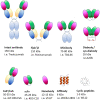Next Generation Imaging Techniques to Define Immune Topographies in Solid Tumors
- PMID: 33584676
- PMCID: PMC7873485
- DOI: 10.3389/fimmu.2020.604967
Next Generation Imaging Techniques to Define Immune Topographies in Solid Tumors
Abstract
In recent years, cancer immunotherapy experienced remarkable developments and it is nowadays considered a promising therapeutic frontier against many types of cancer, especially hematological malignancies. However, in most types of solid tumors, immunotherapy efficacy is modest, partly because of the limited accessibility of lymphocytes to the tumor core. This immune exclusion is mediated by a variety of physical, functional and dynamic barriers, which play a role in shaping the immune infiltrate in the tumor microenvironment. At present there is no unified and integrated understanding about the role played by different postulated models of immune exclusion in human solid tumors. Systematically mapping immune landscapes or "topographies" in cancers of different histology is of pivotal importance to characterize spatial and temporal distribution of lymphocytes in the tumor microenvironment, providing insights into mechanisms of immune exclusion. Spatially mapping immune cells also provides quantitative information, which could be informative in clinical settings, for example for the discovery of new biomarkers that could guide the design of patient-specific immunotherapies. In this review, we aim to summarize current standard and next generation approaches to define Cancer Immune Topographies based on published studies and propose future perspectives.
Keywords: deep learning; imaging techniques; immune exclusion; immune topography; single-cell analysis; solid tumors.
Copyright © 2021 Pietrobon, Cesano, Marincola and Kather.
Conflict of interest statement
VP and FM were employed by the company Refuge Biotechnologies. AC was employed by ESSA Pharmaceuticals. The remaining author declares that the research was conducted in the absence of any commercial or financial relationships that could be construed as a potential conflict of interest.
Figures






Similar articles
-
Hypoxia and the phenomenon of immune exclusion.J Transl Med. 2021 Jan 6;19(1):9. doi: 10.1186/s12967-020-02667-4. J Transl Med. 2021. PMID: 33407613 Free PMC article. Review.
-
A radiomics approach to assess tumour-infiltrating CD8 cells and response to anti-PD-1 or anti-PD-L1 immunotherapy: an imaging biomarker, retrospective multicohort study.Lancet Oncol. 2018 Sep;19(9):1180-1191. doi: 10.1016/S1470-2045(18)30413-3. Epub 2018 Aug 14. Lancet Oncol. 2018. PMID: 30120041
-
Genomic Characterization of Six Virus-Associated Cancers Identifies Changes in the Tumor Immune Microenvironment and Altered Genetic Programs.Cancer Res. 2018 Nov 15;78(22):6413-6423. doi: 10.1158/0008-5472.CAN-18-1342. Epub 2018 Sep 25. Cancer Res. 2018. PMID: 30254145 Free PMC article.
-
Pushing Past the Blockade: Advancements in T Cell-Based Cancer Immunotherapies.Front Immunol. 2021 Nov 18;12:777073. doi: 10.3389/fimmu.2021.777073. eCollection 2021. Front Immunol. 2021. PMID: 34868044 Free PMC article. Review.
-
Status of Immune Oncology: Challenges and Opportunities.Methods Mol Biol. 2020;2055:3-21. doi: 10.1007/978-1-4939-9773-2_1. Methods Mol Biol. 2020. PMID: 31502145 Review.
Cited by
-
The Future of Cancer Diagnosis, Treatment and Surveillance: A Systemic Review on Immunotherapy and Immuno-PET Radiotracers.Molecules. 2021 Apr 11;26(8):2201. doi: 10.3390/molecules26082201. Molecules. 2021. PMID: 33920423 Free PMC article.
-
Extracellular matrix stiffness and tumor-associated macrophage polarization: new fields affecting immune exclusion.Cancer Immunol Immunother. 2024 May 2;73(6):115. doi: 10.1007/s00262-024-03675-9. Cancer Immunol Immunother. 2024. PMID: 38693304 Free PMC article. Review.
-
Cancer immune exclusion: breaking the barricade for a successful immunotherapy.Front Oncol. 2023 May 22;13:1135456. doi: 10.3389/fonc.2023.1135456. eCollection 2023. Front Oncol. 2023. PMID: 37284199 Free PMC article. Review.
-
Whole Slide Imaging-Based Prediction of TP53 Mutations Identifies an Aggressive Disease Phenotype in Prostate Cancer.Cancer Res. 2023 Sep 1;83(17):2970-2984. doi: 10.1158/0008-5472.CAN-22-3113. Cancer Res. 2023. PMID: 37352385 Free PMC article.
-
Dive into Single, Seek Out Multiple: Probing Cancer Metastases via Single-Cell Sequencing and Imaging Techniques.Cancers (Basel). 2021 Mar 3;13(5):1067. doi: 10.3390/cancers13051067. Cancers (Basel). 2021. PMID: 33802312 Free PMC article. Review.
References
-
- Brentjens RJ, Rivière I, Park JH, Davila ML, Wang X, Stefanski J, et al. Safety and persistence of adoptively transferred autologous CD19-targeted T cells in patients with relapsed or chemotherapy refractory B-cell leukemias. Blood (2011) 118:4817–28. 10.1182/blood-2011-04-348540 - DOI - PMC - PubMed
Publication types
MeSH terms
Substances
LinkOut - more resources
Full Text Sources
Other Literature Sources
Medical

